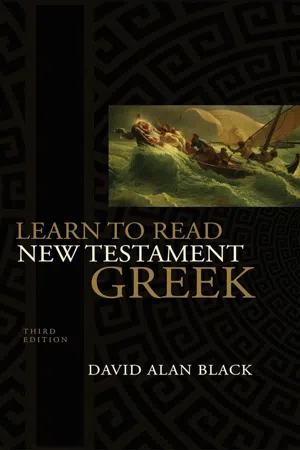
- 272 pages
- English
- ePUB (mobile friendly)
- Available on iOS & Android
Learn to Read New Testament Greek
About this book
An academic staple updated for the first time in fifteen years, David Alan Black 's user-friendly introduction to New Testament Greek keeps discussion of grammar as non-technical as possible. The simplified explanations, basic vocabularies, and abundant exercises are designed to prepare the student for subsequent practical courses in exegesis, while the linguistic emphasis lays the groundwork for later courses in grammar. Revisions to this third edition include updated discussions and scholarship, further back matter vocabulary references, and additional appendices."A streamlined introductory grammar that will prove popular in the classroom."— Murray J. Harris, Trinity Evangelical Divinity School
"Clear charts, clear examples, clear discussion—what more could one want from a beginning grammar!"— Darrell L. Bock, Dallas Theological Seminary
"... combines the strengths of a fairly traditional sequence of topics, in generally manageable chunks with clear explanations fully abreast of modern linguistics."— Craig L. Blomberg, Denver Seminary
"Pedagogically conceived, linguistically informed, hermeneutically sensitive, biblically focused—unique among beginning grammars. It sets a new standard."— Robert Yarbrough, Trinity Evangelical Divinity School
Frequently asked questions
- Essential is ideal for learners and professionals who enjoy exploring a wide range of subjects. Access the Essential Library with 800,000+ trusted titles and best-sellers across business, personal growth, and the humanities. Includes unlimited reading time and Standard Read Aloud voice.
- Complete: Perfect for advanced learners and researchers needing full, unrestricted access. Unlock 1.4M+ books across hundreds of subjects, including academic and specialized titles. The Complete Plan also includes advanced features like Premium Read Aloud and Research Assistant.
Please note we cannot support devices running on iOS 13 and Android 7 or earlier. Learn more about using the app.
Information
1
THE LETTERS AND SOUNDS OF GREEK
1. The Language of the New Testament
2. The Greek Alphabet
| Name | Uppercase | Lowercase... |
|---|
Table of contents
- Cover
- Title Page
- Copyright Page
- Dedication
- Contents
- About This Book
- From Author to Reader
- Preface to Expanded Edition
- Preface to Third Edition
- 1. The Letters and Sounds of Greek
- 2. The Greek Verb System
- 3. Present and Future Active Indicative
- 4. Nouns of the Second Declension
- 5. Nouns of the First Declension
- 6. Adjectives of the First and Second Declensions
- 7. Imperfect and Aorist Active Indicative
- 8. Additional Prepositions
- 9. Personal Pronouns
- 10. Perfect and Pluperfect Active Indicative
- 11. Demonstrative Pronouns
- 12. Present Middle and Passive Indicative
- 13. Perfect Middle and Passive, Future Middle Indicative
- 14. Imperfect Middle and Passive, Aorist Middle, and Pluperfect Middle and Passive Indicative
- 15. Aorist and Future Passive Indicative
- 16. Review of the Indicative Mood
- 17. Nouns of the Third Declension
- 18. Adjectives, Pronouns, and Numerals of the First and Third Declensions
- 19. Contract and Liquid Verbs
- 20. Participles (Verbal Adjectives)
- 21. Infinitives (Verbal Nouns)
- 22. Additional Pronouns
- 23. The Subjunctive Mood
- 24. The Imperative and Optative Moods
- 25. The Conjugation of -μι Verbs
- 26. Reading Your Greek New Testament
- Epilogue: The Next Step
- Appendix 1: The Greek Accents
- Appendix 2: The Greek Alphabet Song
- Appendix 3: Key to the Exercises
- Appendix 4: Noun Paradigms
- Appendix 5: Case-Number Suffixes
- Appendix 6: Person-Number Suffixes
- Appendix 7: Summary of Prepositions
- Appendix 8: Words Differing in Accentuation or Breathing
- Appendix 9: Principal Parts of Selected Verbs
- Greek-English Vocabulary
- Subject Index